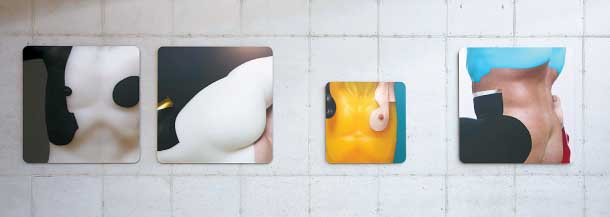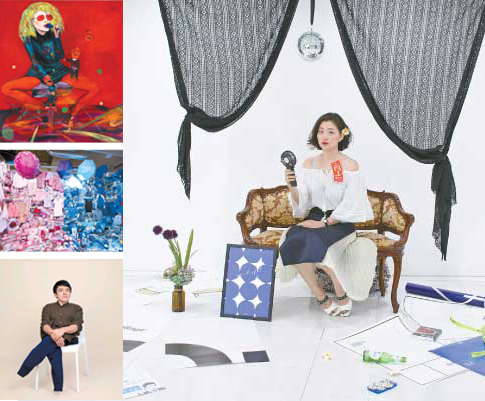The post-Me Generation is on display: Na Na Land exhibition explores what it is to be “I”

Kim Joon explores idea of “gender neutral” through digital prints “Bebe,” “Milk,” “Yellow,” and “Mr. Big” (2019). [SAVINA MUSEUM]
“Na Na Land” is a newly minted concept that is all about “me”, but in a very different, more positive way. It is a play on the title of the 2016 film “La La Land”- na means “I” in Korean - and is one of the top 10 keywords of the year, according to “Trend Korea 2019.”
The guiding principle in “Na Na Land” is that how you look at yourself is more important than what others think. The term not only promotes confidence and body positivity, but also the acceptance of others and their differences.
According to the curators at Savina Museum, the art museum was already planning a new exhibition about self-exploration when they came across the new term.
“Before publication of ‘Trend Korea 2019,’ Savina Museum had designated 2019 as the year of finding yourself,” explained curator Lee Kyung-min at a press briefing last Wednesday at the museum in Eunpyeong district, northern Seoul.
“When we realized how similar ‘Na Na Land’ was to what we were planning, we contacted the staff at ‘Trend Korea’ to collaborate.” The “Trend Korea” series is published by the Seoul National University’s Consumer Trend Center.
Thus was born “Na Na Land: It’s My World,” a 64-piece collection of paintings, photographs, installations, videos and interactive projects by 21 artists.

From bottom left: A portrait from Yoo Hwa-soo and Lee Jee-yang’s “Your Angle” (2018) project, which features individuals with physical disabilities. Yoon Jeong-mee’s “Pink Space and Blue Space” (2019). Hwang Young-ja’s “Interview” (2012), where the artist portrays herself as a flamboyant pop diva. Above: A photograph from art duo Bbreka’s ongoing project “Photo studio for one-person households” (2016-present). [SAVINA MUSEUM]
The interactive installations of “Na Na Land” are easily the highlights of the exhibition.
Tongjjwa’s “Name Show” (2019) offers visitors a chance to find themselves a new name, an integral part of one’s permanent identity. The installation is made up of a lottery machine that randomly selects balls inscribed with different Korean consonants and vowels.
At Koh Jae-wook’s “DIE For” (2016, 2019), visitors can sing their hearts out in a small, transparent karaoke room covered with mirrors inside, wholly focusing on their reflection and sounds. Chun Kyung-woo‘s “Portrait Made by Hand” (2010) installation, also fitted with mirrors, is a work in progress completed by the participants themselves. Visitors are encouraged to write down a self-description of their appearance and stick it on the wall.
A sofa and a tripod - the props used for art duo Bbreka’s ongoing project “Photo studio for one-person households” (2016-present) - create a fun photo zone in “Na Na Land.”
There’s more to the photo set than just a pretty sofa, however. With the goal of overcoming prejudices surrounding the growing number of one-person households, Bbreka began inviting people who live alone to sit on a sofa in their studio and talk about their situations while posing for photographs, also displayed at the exhibition.
The pronunciations for household and furniture are the same in Korean.
“When we first started the project [in 2016], we had in mind people who lived alone because of their personal choices like careers,” Shin Jae-eun of Bbreka explained at the briefing. “But we began to find out that a lot of people were forced into the situation due to social circumstances. There are a lot of prejudices assumed with one-person households.”
Other pieces in “Na Na Land” also encourage discussion of social issues through evocative images.
Sculptor Yoo Hwa-soo and photographer Lee Jee-yang tackle the issue of body positivity through the “Your Angle” (2018) project, which features portraits of seven individuals with physical disabilities, a group of people rarely represented in Korean art or media. Amputations and contorted hands are on public display, reminding the audience that there’s more to body positivity.
Yoon Jeong-mee’s “Pink Space and Blue Space” (2019) is a colorful contrast of blue and pink children’s items, a continuation of Yoon’s widely acclaimed Pink and Blue Project addressing relations between gender and consumerism. Yoon started the project after noticing that young girls - including her 5-year-old daughter - filled their rooms with pink books, clothes and shoes, while blue hues seemed to dominate boys’ rooms.
The “Na Na Land” exhibition runs through July 7, with hours from 10 a.m. to 6:30 p.m., excluding Mondays.
English guided tours of the exhibition will be offered by a teacher from the Goyang Foreign Language High School on the last Saturday of each month.
Admission is 8,000 won ($7) for adults. For more information, visit www.savinamuseum.com.
BY KIM EUN-JIN [kim.eunjin1@joongang.co.kr]










with the Korea JoongAng Daily
To write comments, please log in to one of the accounts.
Standards Board Policy (0/250자)